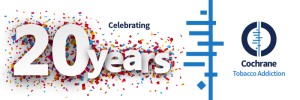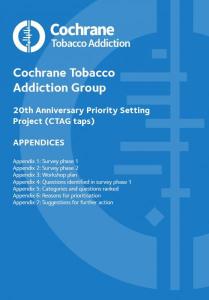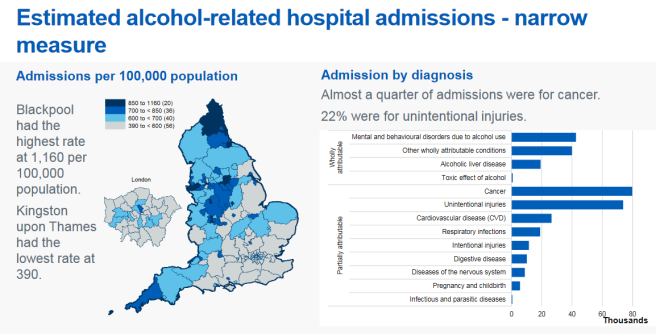Research
New Publication from the Sheffield Alcohol Research Group: Model-based appraisal of the comparative impact of Minimum Unit Pricing and taxation policies in Wales
Three quarters of all alcohol consumed in Wales is drunk by less than a quarter of the adult population who are hazardous or harmful drinkers and spend up to £2,882 per year on booze, research has revealed.
A report looking into the potential impact of minimum unit pricing and taxation policies in Wales was published Thursday 22nd February by the Sheffield Alcohol Research Group at the University of Sheffield.
The publication, which found that the 3% of the population who are harmful drinkers, account for 27% of all alcohol consumed, comes after the Welsh Government announced a new Bill that, if agreed by the National Assembly, will introduce a minimum price for the sale of alcohol.
The Bill, which is designed to reduce hazardous and harmful drinking would make it an offence for alcohol to be supplied below that price.
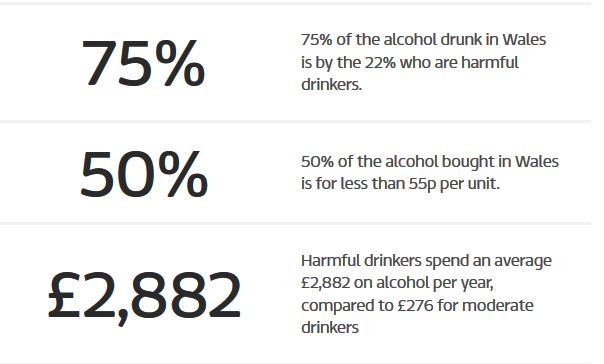
Health Secretary, Vaughan Gething said: “People who drink alcohol at hazardous and harmful levels drink 75% of the alcohol consumed in Wales.
“The introduction of a minimum unit price would be effective in reducing alcohol consumption among these groups, as well as reducing the number of alcohol-related deaths and hospitalisations.”
The availability of cheap, strong alcohol is estimated to lead to 50,000 alcohol-related hospital admissions a year, costing the Welsh NHS £120 million annually and, in 2015, there were 463 alcohol-related deaths in Wales.
The report reveals the population of Wales buys 50% of its alcohol for less than 55p per unit, 37% for less than 50p per unit and 27% for less than 45p per unit, with heavier drinkers being more likely to buy alcohol sold below these thresholds.
Mr Gething said: “The report shows the greatest impact of a minimum unit price would be on the most deprived harmful drinkers, while moderate drinkers would experience only small impacts on their alcohol consumption and spending.
“This is because moderate drinkers tend to buy alcohol which would be subject to little or no increase in price under the policy.
“If passed, this law will potentially save lives.”
The research also shows harmful drinkers spend an average £2,882 a year on alcohol, or around £7.80 per day, compared to £1,209 for hazardous drinkers and £276 for moderate drinkers.
The Sheffield Alcohol Research Group, commissioned by the Welsh Government in June 2017 to update a 2014 appraisal of the likely impact of a range of minimum unit pricing policies, concluded a minimum unit price set at between 35p and 70p would be effective in reducing alcohol consumption among hazardous and, particularly, harmful drinkers.
Research highlights:
- Moderate drinkers drink an average of 211 units of alcohol per year compared to 1,236 for hazardous drinkers and 3,924 for harmful drinkers.
- Harmful drinkers spend an average £2,882 a year on alcohol compared to £1,209 for hazardous drinkers and £276 for moderate drinkers.
- Alcohol-attributable deaths and hospital admissions are concentrated in hazardous and particularly harmful drinkers who are more deprived.
External news coverage:
75% of alcohol in Wales is drunk by just over a fifth of the population according to new report – ITV News
Minimum alcohol price help call for ‘hazardous’ drinkers – BBC News
75% of alcohol drunk in Wales consumed by 22% of the population, report says – Guernsey Press
New Systematic Review: Effectiveness of Mass Media Campaigns to Reduce Alcohol Consumption and Harm
 The search produced 10,212 results and 24 studies were included in the review. Most of the campaigns used TV or radio in combination with other media channels. There was little evidence of reduction in alcohol consumption associated with exposure to campaigns based on 13 studies which measured consumption, although most did not state this as a specific aim of the campaign. There were some increases in treatment seeking and information seeking and mixed evidence of changes in intentions, motivation, beliefs and attitudes about alcohol. Campaigns were associated with increases in knowledge about alcohol consumption, especially where levels had initially been low.The evidence suggests mass media health campaigns about alcohol can be recalled by individuals and can achieve changes in knowledge, attitudes and beliefs about alcohol, based mainly on weak quality studies. Findings of studies that measured alcohol consumption suggest campaigns have not reduced consumption, although most did not state that they directly aim to do so.
The search produced 10,212 results and 24 studies were included in the review. Most of the campaigns used TV or radio in combination with other media channels. There was little evidence of reduction in alcohol consumption associated with exposure to campaigns based on 13 studies which measured consumption, although most did not state this as a specific aim of the campaign. There were some increases in treatment seeking and information seeking and mixed evidence of changes in intentions, motivation, beliefs and attitudes about alcohol. Campaigns were associated with increases in knowledge about alcohol consumption, especially where levels had initially been low.The evidence suggests mass media health campaigns about alcohol can be recalled by individuals and can achieve changes in knowledge, attitudes and beliefs about alcohol, based mainly on weak quality studies. Findings of studies that measured alcohol consumption suggest campaigns have not reduced consumption, although most did not state that they directly aim to do so.
The finding that campaigns can be recalled suggests appropriate media channels, targeting strategies, durations and intensities have been utilized to reach target audiences. These campaign characteristics were not always reported by studies so it is not possible to draw a link between types of campaign strategies and levels of recall or exposure. Recall of tobacco mass media campaigns has been shown to be positively associated with smoking cessation (Jepson et al., 2007) so the outcome may be an important first step towards subsequent behaviour change in populations.
Most campaigns that aimed to improve knowledge were shown to be effective. This was particularly evident in areas where knowledge was initially low, for example, knowledge of unit consumption guidelines and of the link between alcohol and cancer. Mass media can yield sustained knowledge, which may lay the groundwork for reductions in consumption that are achieved using other public health measures.
There was evidence of increases in information seeking and treatment seeking. However, alcohol campaigns have not presented the simple call to action of tobacco messages (‘quit’) or provided offers of tangible help such as ‘quitlines’. Furthermore, as alcohol support services have historically been aimed at very heavy drinkers there may be a perception that current services do not cater for those who drink less. Mass media might therefore have limited utility in promoting service uptake.
Most studies found no impact on alcohol consumption, consistent with the conclusion of a previous review that there should be modest expectations of behaviour change from such campaigns (Snyder et al., 2004). Longer term evaluations conducted following sustained and repeated exposure to campaigns might be expected to be better able to detect effects on behaviour. However, the relationship between tobacco mass media campaign duration and effectiveness has been difficult to gauge due to confounding influences and trends over time (Durkin et al., 2012). The context in which alcohol health promotion campaigns operate is particularly challenging because of the ubiquity and power of alcohol marketing (de Bruijn et al., 2016) and pro-alcohol cultural norms (Gordon et al., 2012). This is another key difference to tobacco, where health campaigns in recent years have run in a context where most tobacco marketing has been banned or strictly regulated and social norms have become increasingly anti-smoking. The current review found evidence of impact on short term intermediate outcomes, suggesting mass media can play a supportive role for other actions which are more likely to have an impact on behaviour. These might include price-based measures (Babor et al., 2010), advertising restrictions (Siegfried et al., 2014), limiting availability and access to alcohol (Anderson et al., 2009) with the targeting of high risk groups (Foxcroft et al., 2015).
Society for the Study of Addiction – Annual Conference 2017

9th – 10th November 2017
Crowne Plaza, Newcastle, UK
Confirmed sessions include:
- Sport & exercise in addiction and recovery with personal reflections from Clarke Carlisle.
- End of life care for people with substance problems.
- The psychedelic renaissance in addiction treatment.
- Pathways to amphetamine type stimulant use.
NEW for 2017: The ADDICTION DEBATE
‘This Society believes it is appropriate to expand the concept of addiction to behaviours such as internet use’
With Professor Robert West & Professor Mark Griffiths
SSA PhD Symposium 2017
New for 2017, the SSA’s PhD Symposium will be held the day before our annual Conference, in the same venue.
The SSA’s symposium for PhD students is now in its ninth year. This event aims to bring together PhD students studying addiction-related topics so they can network, present their work in a low-key, supportive environment and share their ups and downs. It welcomes full and part-time students, studying in a range of disciplines including social sciences, laboratory sciences and health services research. The day includes presentations from students at various stages in the PhD process and some close to or who have recently submitted their thesis.
There is a social event in the evening of the PhD Symposium, and throughout the day there is plenty of opportunity to talk to other delegates.
For more information about this event please visit: www.addiction-ssa.org/symposium
The Cochrane Tobacco Addiction Group’s 20th anniversary priority setting project report.
The objective of the project was to:
- Raise awareness of Cochrane TAG and what has been achieved so far.
- Identify areas where further research is needed in the areas of tobacco control and smoking cessation.
- Identify specific goals for Cochrane TAG
- To explore novel ways to disseminate the findings of tobacco research, and Cochrane TAG’s findings.
The survey and workshop resulted in 183 unanswered research questions in the areas of tobacco, quitting smoking and eight priority research areas, including:
- ‘addressing inequalities’
- ‘treatment delivery’
- electronic cigarettes’
- ‘initiating quit attempts’
- ‘young people’
- ‘mental health and substance abuse’
- ‘population-level interventions’
- ‘pregnancy’

Stakeholders who attended the workshop also discussed ways that the public health community and Cochrane TAG could act to move the field of tobacco control forward.
Through this report, Cochrane TAG want to share the identified unanswered questions with the wider tobacco research community to help them to decide the most important research to focus on in the future, and to decide the most important things to work on for Cochrane TAG.
This will involve updating existing reviews, beginning reviews on new topics, and looking in more detail at Cochrane TAG’s research methods.
Contrary to popular belief there are still many important unanswered questions in the field of tobacco control. In addition, it has been noted that many of the results of tobacco control questions are not always reaching their intended targets. Tobacco control stakeholders provide a rich source of information on how these uncertainties should be prioritised; by using this resource the likelihood that the findings of research are useful and will be implemented is much greater. The project was carried out with the hope that researchers and research funders will be able to use the priorities identified to inform their future practice, in the same way that Cochrane TAG are using them to inform new review topics, updates of reviews and methods development.
Cochrane TAG’s findings and implementation suggestions should be considered alongside the existing evidence base and clinical expertise.
Discussing the future of tobacco addiction research with the Cochrane Tobacco Addiction Group:
The CTAG taps project ran from January-December 2016. Activities carried out from April 2016-December 2016 were funded by the NIHR School for Primary Care Research (SPCR)
Introducing a new International Workshop: The Ubiquity of Alcohol – 20/09/2017

We are delighted to announce the launch of a brand new international workshop focusing on the ubiquity of alcohol.
Addressing Marketing, Availability and Industry Influence:
Alcohol is no ordinary commodity but its presence and marketing seem ubiquitous. In this workshop, we will explore how policymakers, public health experts and researchers are responding to industry efforts to expand the presence and normality of alcohol in our lives. With inputs from leading international researchers and advocates we will explore alcohol marketing and availability in a digital age; industry manoeuvres, and potential countermeasures.
This years workshop will feature sessions from a variety of speakers including a session on Alcohol Marketing and the loi Évin, which is a French alcohol and tobacco policy that was passed in 1991. In this session Nathan Critchlow from the University of Stirling and Prof Karine Gallopel-Morvan from the EHESP School of Public Health, France will look at consumer marketing of alcohol brands in a digital age, controlling alcohol advertising and lessons learnt from the loi Évin.
We also have inputs from a variety of speakers from a number of organisations that focus on alcohol harm, including Jon Foster from the Institute of Alcohol Studies and Alison Douglas & Laura Mahon from Alcohol Focus Scotland.
We are also pleased to announce that Prof. Mike Daube from Curtin University, Australia will be joining us to discuss advocacy on alcohol advertising and the influence of the alcohol industry. To discuss the alcohol industry in more detail we also welcome Prof. Jeff Collin from the University of Edinburgh. Jeff is a regular speaker at the Alcohol Policy in Practice CPD and provides a deep insight into the alcohol industry actions.
The Ubiquity of Alcohol
Location: University of Stirling
Date: Wednesday 20th September
Cost: Standalone workshop cost: £150.00
More information: www.ukctas.net/ubiquity
This workshop is included in our 4 day Alcohol Policy in Practice CPD course we run every September, to find out more information about this course and it’s content please click here.
Alcohol and breast cancer – How big is the risk? ~ Report from the World Cancer Research Fund
‘Half a glass of wine a day increases breast cancer‘ was just one of the headlines this  week, which discussed a report that reinforced the evidence that alcohol can increase a woman’s risk of developing breast cancer.
week, which discussed a report that reinforced the evidence that alcohol can increase a woman’s risk of developing breast cancer.
The report from the World Cancer Research Fund outlined the latest evidence on how we can reduce that risk – focusing on weight, physical activity and drinking.
The WCRF studies all the evidence on a potential risk and decides whether it’s strong enough to be a basis for making recommendations to the public.
Breast cancer is the most common cancer in the UK, and 1 in 8 women will be diagnosed with breast cancer at some point in their lives. And since we know that almost a third of breast cancer cases in the UK could be prevented, largely by changes to lifestyle, this is important stuff.
While the cause of an individual’s cancer can never be certain, there are still things you can do to reduce your risk. And evidence like this is the first step to helping women to do just that.
So what exactly does the report say?
Alcohol
The report backs up previous research showing that drinking alcohol can cause 7 types of cancer including breast cancer. Even though it’s in the headlines, this is nothing new.
While the reports may sound alarming, we also know that the more you cut down, the more you’re reducing your risk.
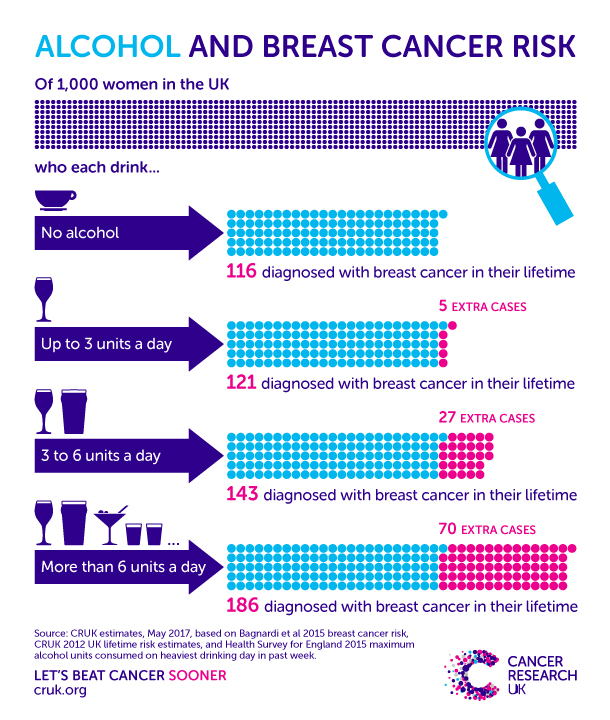
Although most women don’t regularly drink very large amounts of alcohol, thousands of cases of cancer – including breast – are linked to alcohol each year.
There are 3 good theories on the link between alcohol and cancer which we’ve written about before.
- When we drink alcohol, it’s broken down into a toxic chemical called acetaldehyde. Acetaldehyde can damage the DNA inside our cells, and then prevent damage from being repaired. This is important because it allows cancer to develop.
- Alcohol can increase the levels of certain hormones in the body, including oestrogen. We know that high levels of oestrogen can fuel the development of breast cancer, so this might be particularly important here.
- Alcohol also makes it easier for cells in the mouth and throat to absorb other cancer-causing chemicals. This is probably more important for other cancer types linked to alcohol rather than breast cancer.
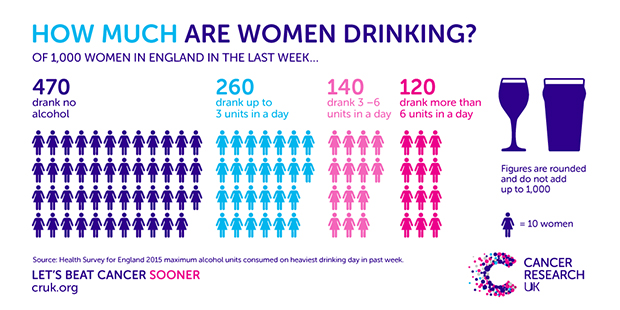
Physical activity
The evidence on the link between breast cancer risk and both weight and physical activity is a bit more complicated. This is because there is evidence that the causes of breast cancer that occur in women before the menopause, compared to after the menopause, are different.
But overall there is strong evidence that keeping a healthy weight and being physically active, can help prevent breast cancer.
Unlike its previous report, this time WCRF says that some forms of physical activity probably reduce the risk for pre-menopausal breast cancer But the finding is only true for ‘vigorous’ activity – exercise which gets you breathing hard and your heart beating fast, so that you won’t be able to say more than a few words without pausing for breath.
The report also adds to the existing evidence that physical activity at any age is related to a lower risk of breast cancer in women after the menopause. This can be anything that gets you a bit hot and out of breath – from fast walking, to cycling, or even heavy housework. And the more you do the better.
Body weight
The evidence on weight and breast cancer is also complicated: as your risk changes depending on the ages at which you were overweight.
But overall the report agrees with previous work showing that being overweight or obese throughout adulthood causes postmenopausal breast cancer, something that is already well established.
Bringing it all together
Other things that affect a woman’s breast cancer risk are less easy to control. As with most cancers, the risk of developing the disease increases with age. Having a family history of the disease can increase a woman’s risk, and breastfeeding can reduce it.
All the different things that can increase the risk of breast cancer are held together by a common thread: they all affect the hormones circulating around in the body in some way.
Hormones help control what happens inside our bodies by sending messages from one place to another – including instructing cells when to stop and start multiplying.
If this system goes wrong, cells can get too many messages telling them to make more cells. And that can lead to cancer.
Overall the best advice is the same as at the start of the week: to keep active, keep a healthy weight throughout life, and limit alcohol.
Originally posted on CRUK, taken from Cancer Research UK Cambridge Institute
Study finds poorest of us at greater risk of harm from heavy drinking.

Drinking heavily is more harmful to the poorest people in society, who are at greater risk of illness or death because of alcohol consumption, according to a recent medical study. Published in medical journal The Lancet Public Health on Wednesday, it found there is a marked link between socio-economic status and the harm caused by drinking alcohol excessively.
Researchers taking part in the study found increased alcohol consumption was “disproportionately harmful” to the poorest in society. Compared with light drinkers in advantaged areas, excessive drinkers were seven times at risk of an increase in alcohol harm.
This contrasted with excessive drinkers in deprived areas, who were 11 times at risk of an increase. Harmful impacts of alcohol are higher in socio-economically disadvantaged communities. However, until now it was unclear whether those were as a result of
differences in drinking or as a result of other factors.
Lead author Dr Vittal Katikireddi, of the University of Glasgow, said:
“Our study finds that the poorest in society are at greater risk of alcohol’s harmful impacts on health, but this is not because they are drinking more or more often binge drinking.
“Experiencing poverty may impact on health, not only through leading an unhealthy lifestyle but also as a direct consequence of poor material circumstances and psychosocial stresses. Poverty may, therefore, reduce resilience to disease, predisposing people to greater health harms of alcohol.“
The authors linked different sets of data to bring together information from Scottish Health Surveys with electronic health records, studying more than 50,000 people.
It suggested that even when other factors are accounted for, including smoking and obesity, living in deprived areas was consistently associated with higher alcohol-related harms. Researchers defined harm from alcohol consumption based on deaths, hospital visits and prescriptions that were attributable to alcohol.
Study co-author Dr Elise Whitley said:
“Heavier drinking is associated with greater alcohol-related harm in all individuals. However, our study suggests that the harm is greater in those living in poorer areas or who have a lower income, fewer qualifications or a manual occupation.“
Responding to the study published on Wednesday in The Lancet Public Health which found that drinking heavily is more harmful to the poorest people in society. Professor Sir Ian Gilmore, chair of the Alcohol Health Alliance UK (AHA), said:
“The findings in this study are worrying if not altogether surprising. It is clear that the way alcohol is being sold and promoted in Scotland and elsewhere in the UK is harming some of the most vulnerable people in society. On the other hand, we know what needs to be done, in particular to tackle the scourge of cheap alcohol. In real terms, alcohol is 60% cheaper than it was in 1980 and measures like strength based pricing would disproportionately benefit the poorest groups, in terms of reduced deaths, illness and hospital admissions.
Studies have shown that 82% of the lives saved through minimum unit pricing would come from the lowest income groups. Overall, in the first year alone minimum unit pricing in Scotland is expected to save 60 lives and lead to 1,600 fewer hospital admissions and 3,500 fewer crimes, yet its introduction has been held up for years by alcohol industry legal challenges.
Importantly, minimum unit pricing would leave pub prices untouched, and moderate drinkers would spend only about £2.25 extra per year with a 50p minimum price.”
This is even more evidence of the Alcohol Harm Paradox, which refers to observations that lower socioeconomic status (SES) groups consume less alcohol but experience more alcohol-related problems. However, SES is a complex concept and its observed relationship to social problems often depends on how it is measured and the demographic groups studied. A study published in 2016 hoped to deconstruct this idea and assessed socioeconomic patterns of alcohol consumption and related harm using multiple measures of SES and examined moderation of this patterning by gender and age. You can read the research article here: Deconstructing the Alcohol Harm Paradox: A Population Based Survey of Adults in England
Citation of original research article:
Socioeconomic status as an effect modifier of alcohol consumption and harm: analysis of linked cohort data.
10th annual Global Research Awards for Nicotine Dependence (GRAND) program

GRAND is a Pfizer-supported independently reviewed competitive grants program awarding individual grants of up to $200,000 from a total fund in 2017 of $1 million to support projects which directly advance the use of pharmacotherapy for treating users of any nicotine or tobacco product in clinical practice. Of 486 applications received since 2008, 62 grants have been awarded.
Pfizer has called for Clinical research proposals that aim to increase the understanding of the mechanisms of tobacco and nicotine dependence and its treatment. The overall mission of the GRAND program is to advance the pharmacological treatment of tobacco and nicotine dependence.
Each proposal should fall into one of the following areas:
- Human laboratory (e.g., pharmacokinetics, pharmacodynamics, cravings, withdrawal);
- Pharmacotherapy of smoking cessation and relapse, and / or its interaction with behavioral support;
- Characterization of subtypes of smokers; suitability for appropriate interventions.
Research projects should aim to provide information that could directly advance the use of pharmacotherapy for treating users of any nicotine or tobacco product in clinical practice. Examples could include:
- Observational or interventional studies of pharmacotherapy
- Optimization of the use of currently available medication
- Effectiveness of pharmacotherapy in real-life settings
- Development or use of new medications for cessation or harm reduction
- Specifically designed pharmacotherapy in subtypes of tobacco/nicotine users
- Use of existing databases to inform the clinical use of pharmacotherapy
- Policy interventions to increase use of pharmacotherapy.
The intent of the program is to fund at least 6 awards of between $50,000 and $200,000 in value, totaling $1.2 million. The awards are open to all investigators and they would strongly encourage applications from junior investigators.
Applications will be formally assessed by, and only by, the GRAND Review Committee, an independent committee comprising internationally prominent researchers in the field. The final responsibility for selection of Awardees rests with the Co-Chairs of the Review Committee, John Hughes and Karl Fagerstrom. The whole process is completely independent of Pfizer, including the final selection of Awardees.
GRAND is open to all investigators from around the world holding an MD, a PhD, or equivalent.
Application deadline: July 3, 2017
To apply for the grant and for more information on the application process click here!
Alcohol-related Hospital Admissions are at a Record High!

New figures released this week shows that hospital admissions due to alcohol are at their highest ever levels.
The data, summarised in a release from NHS Digital, shows that alcohol-related hospital admissions in England have increased by 64% over the last decade, with an extra 430,000 people being admitted due to alcohol-related causes in 2015/16 compared with 2005/06.
This takes the total number of alcohol-related hospital admissions to over 1.1 million in 2015/16.

Alcohol is linked to over 60 illnesses and diseases, including heart disease, liver disease and cancer. Figures from the local alcohol profiles for England show that admissions due to liver disease have gone up 57% over the last decade, and that the number of people diagnosed with alcohol-related cancer has increased 8%.
In contrast, separate data released today by the Office of National Statistics shows that the proportion of adults drinking is at its lowest level since 2005, with younger people more likely to be abstaining from alcohol. However, 7.8 million people admit to binge drinking on their heaviest drinking day.
In response to the figures, alcohol health experts called for more to be done in the UK to tackle the health harm done by alcohol.
Professor Sir Ian Gilmore, chair of the Alcohol Health Alliance UK (AHA), said:
“These figures show that the UK continues to have a dysfunctional relationship with alcohol. We know that over the long term, rates of binge drinking are falling, and more people are choosing to abstain from alcohol. Worryingly, however, these trends do not appear big enough to stop alcohol harm from continuing to rise, and the sharp increase in alcohol-related hospital admissions over the last few years means hundreds of thousands more people each year are experiencing the misery associated with harmful alcohol consumption.
“The data released today should be sobering reading for whoever wins the upcoming general election, and we would urge the next government to make tackling alcohol harm an immediate priority to save lives, reduce harm, and reduce the pressure on the NHS.”
The data is available via the following links.


